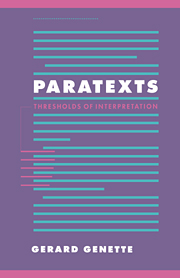Book contents
- Frontmatter
- Contents
- Foreword
- List of books by Gérard Genette
- Translator's note
- 1 Introduction
- 2 The publisher's peritext
- 3 The name of the author
- 4 Titles
- 5 The please-insert
- 6 Dedications and inscriptions
- 7 Epigraphs
- 8 The prefatorial situation of communication
- 9 The functions of the original preface
- 10 Other prefaces, other functions
- 11 Intertitles
- 12 Notes
- 13 The public epitext
- 14 The private epitext
- 15 Conclusion
- Additional references
- Index
2 - The publisher's peritext
Published online by Cambridge University Press: 04 November 2009
- Frontmatter
- Contents
- Foreword
- List of books by Gérard Genette
- Translator's note
- 1 Introduction
- 2 The publisher's peritext
- 3 The name of the author
- 4 Titles
- 5 The please-insert
- 6 Dedications and inscriptions
- 7 Epigraphs
- 8 The prefatorial situation of communication
- 9 The functions of the original preface
- 10 Other prefaces, other functions
- 11 Intertitles
- 12 Notes
- 13 The public epitext
- 14 The private epitext
- 15 Conclusion
- Additional references
- Index
Summary
I give the name publisher's peritext to the whole zone of the peritext that is the direct and principal (but not exclusive) responsibility of the publisher (or perhaps, to be more abstract but also more exact, of the publishing house) – that is, the zone that exists merely by the fact that a book is published and possibly republished and offered to the public in one or several more or less varied presentations. The word zone indicates that the characteristic feature of this aspect of the paratext is basically spatial and material. We are dealing here with the outermost peritext (the cover, the title page, and their appendages) and with the book's material construction (selection of format, of paper, of typeface, and so forth), which is executed by the typesetter and printer but decided on by the publisher, possibly in consultation with the author. All these technical givens themselves come under the discipline called bibliology, on which I have no wish to encroach; here my concern with them extends only to their appearance and effect, that is, only to their strictly paratextual value. Besides, this paratext's dependence on the publisher basically assigns it to a relatively recent historical period, whose terminus a quo coincides with the beginnings of printing, or the period historians ordinarily call modern and contemporary. This is not to say that the (much longer) pre-Gutenberg period, with its handwritten copies that were really even then a form of publication, knew nothing of our peritextual elements; and below we will have reason to ask how antiquity and the Middle Ages handled such elements Chértien as the title or the name of the author, whose chief location today is the publisher's peritext.
- Type
- Chapter
- Information
- ParatextsThresholds of Interpretation, pp. 16 - 36Publisher: Cambridge University PressPrint publication year: 1997



